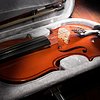Laws governing travel with a musical instrument vary from country to country, but many places now have rules on the books that dictate how airlines must accommodate musicians traveling with precious cargo. In the United States, the Department of Transportation implemented the FAA Modernization and Reform Act of 2012, which mandates air carriers allow passengers to bring small instruments such as a guitar or violin as carry-on luggage, provided those instruments can be properly stored per FAA safety regulations.
Of course, there are exceptions to every rule and variations from carrier to carrier. With that in mind, here are a few handy tips to ensure you’re priceless viola or bouzouki gets from point A to point B in one piece:
1. Prepare for Lift Off

If you’re flying, loosen the strings on your instrument to accommodate temperature changes. Remove any potentially dangerous accessories like weighty metal capos, and if you’re checking your instrument, write a clear and concise note to security detailing how your instrument should be repacked for safe travel. Lastly, put a big, bold fragile sticker on your case. Better yet, add a couple stickers, and put them in very conspicuous spots.
2. Get Familiar with Your Airline’s Luggage Policy
Even when the law is in your favor, airline staff may not be familiar with regulations and boarding is not an ideal time to run into trip-altering hurdles. Read up on each airline’s policy before booking your ticket, and, whenever possible, get confirmation in writing that you’re allowed to fly with your instrument. Bring that letter with you to the airport just in case you encounter resistance.
3. Leave Room in Your Schedule for Security Checks

Instruments are often subject to extra scrutiny. After your instrument is x-rayed, security agents may also conduct a physical inspection and explosives trace detection test, and all of that takes time.
4. Board Early
Since overhead compartment space is generally available on a first come, first served basis, it’s worth paying extra to board early and ensure your instrument gets a spot. If early boarding isn’t an option or if you’re flying on a small commuter-style aircraft, ask about gate-checking your instrument instead. For larger instruments like a harp, consider buying a second seat.
5. Invest in a Travel Friendly Case
Instruments fare best in hard-shell cases with expertly designed suspension, especially if you plan on checking your instrument. Many brands offer extra features that help out when you’re on foot at a festival or running for a taxi as well as hopping on a flight. In addition to packing a high-density foam interior and air-tight accessory space, the Bam France Trekking Violin Case comes with a pull-out waterproof nylon cover and backpack straps. Style Acoustic Guitar makes its line of cases using ATA-molded, military-grade polyethylene and TSA-approved locking latches.
6. Have an Insurance Policy in Place
Airlines are careful to limit their liability. Protect yourself with a third-party insurance policy so that if something does go wrong, you’ll have funds for repair or replacement.

Whether you’re headed to the next date on your tour or just taking your ukulele home for a casual performance at a family reunion, making beautiful music requires an instrument that arrives in tip-top shape. With just a little preparation and research, you can safeguard your next sonata—and perhaps even your career.











